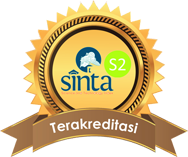Development of Students’ Conceptual Understanding through STEAM Project Integration in Thermochemistry
DOI:
https://doi.org/10.15575/jtk.v6i1.5498Keywords:
conceptual understanding, thermochemistry, STEAM projectAbstract
This study aims to develop students' conceptual understanding by integrating the Science, Technology, Engineering, Art, and Mathematics (STEAM) project in thermochemistry. The qualitative research was employed with interviews, reflective journals, observations, students’ worksheets, and conceptual understanding tests on 40 students in senior high school. The STEAM project was implemented through a project-based learning model to develop students' understanding of exothermic and endothermic, combustion reactions, and enthalpy concepts. The STEAM project being developed is a steamship using three fuels: methanol, ethanol, and palm oil. The results showed that the student's understanding of enthalpy calculation had developed. Otherwise, the concept of exothermic, endothermic, and combustion reaction, especially related to applying the concept in daily life, is still undeveloped. Thus, some of the students experienced misconceptions. Therefore, the integration of contextual learning such as STEAM needs to be continuously applied to provide students with opportunities to develop their conceptual understanding and application in daily life.
References
Adriyawati, A., Utomo, E., Rahmawati, Y., & Mardiah, A. (2020). STEAM-Project-based learning integration to improve elementary school students’ scientific literacy on alternative energy learning. Universal Journal of Educational Research, 8(5), 1863–1873. https://doi.org/10.13189/ujer.2020.080523
Anderson, E. E., Taraban, R., & Sharma, M. P. (2005). Implementing and assessing Computer-based active learning materials in introductory thermodynamics. International Journal of Engineering Education, 21(6), 1168-1176. Retrieved from https://www.ijee.ie/articles/Vol21-6/18_Ijee1576.pdf
Ayyildiz, Y., & Tarhan, L. (2018). Problem-based learning in teaching chemistry: Enthalpy changes in systems. Research in Science & Technological Education, 36(1), 35–54. https://doi.org/10.1080/02635143.2017.1366898
Bahrum, S., Wahid, N., & Ibrahim, N. (2017). Integration of STEM education in Malaysia and why to STEAM. International Journal of Academic Research in Business and Social Sciences, 7(6), 645-654. https://doi.org/10.6007/IJARBSS/v7-i6/3027
Chen, F., Zhang, S., Guo, Y., & Xin, T. (2017). Applying the rule space model to develop a learning progression for thermochemistry. Research in Science Education, 47(6), 1357–1378. https://doi.org/10.1007/s11165-016-9553-7
Chiang, C. L., & Lee, H. (2016). The effect of Project-based learning on learning motivation and problem-solving ability of vocational high school students. International Journal of Information and Education Technology, 6(9), 709–712. https://doi.org/10.7763/IJIET.2016.V6.779
Childs, P. E., Hayes, S. M., & O’dwyer, A. (2015). Chemistry and everyday life: relating secondary school chemistry to the current and future lives of students. In: Eilks I., Hofstein A (Eds.), Relevant Chemistry Education, (pp. 33–54). Sense Publishers. https://doi.org/10.1007/978-94-6300-175-5_3
Eilks, I., Moellering, J., & Valanides, N. (2007). Seventh-grade students’ understanding of chemical reactions: reflections from an action research interview study. EURASIA Journal of Mathematics, Science and Technology Education, 3(4), 271-286. https://doi.org/10.12973/ejmste/75408
English, L. D. (2016). STEM education K-12: Perspectives on integration. International Journal of STEM Education, 3(3), 1-8. https://doi.org/10.1186/s40594-016-0036-1
Fensham, P. J. (2009). Real world contexts in PISA science: Implications for context-based science education. Journal of Research in Science Teaching, 46(8), 884–896. https://doi.org/10.1002/tea.20334
Glancy, A. W., & Moore, T. J. (2014). Theoretical foundations for effective stem learning environments. School of Engineering Education Working Papers, (1). Retrieved from https://docs.lib.purdue.edu/enewp/1
Greenbowe, T., & Meltzer, D. (2003). Student learning of thermochemical concepts in the context of solution calorimetry. International Journal of Science Education, 25(7), 779–800. https://doi.org/10.1080/09500690305032
Gross, K., & Gross, S. (2016). Transformation: constructivism, design thinking, and elementary STEAM. Art Education, 69(6), 36–43. https://doi.org/10.1080/00043125.2016.1224869
Guba, E. G., & Lincoln, Y. (1989). Fourth generation evaluation. Newbury Park: SAGE Publications.
Guzey, S. S., Harwell, M., Moreno, M., Peralta, Y., & Moore, T. J. (2017). The Impact of Design-based STEM integration curricula on student achievement in engineering, science, and mathematics. Journal of Science Education and Technology, 26(2), 207–222. https://doi.org/10.1007/s10956-016-9673-x
Hadinugrahaningsih, T., Rahmawati, Y., & Ridwan, A. (2017). Developing 21st century skills in chemistry classrooms: Opportunities and challenges of STEAM integration. 030008. https://doi.org/10.1063/1.4995107
Hattan, C., & Alexander, P. A. (2020). Prior knowledge and its activation in elementary classroom discourse. Reading and Writing, 33(6), 1617–1647. https://doi.org/10.1007/s11145-020-10022-8
Holme, T. A., Luxford, C. J., & Brandriet, A. (2015). Defining conceptual understanding in general chemistry. Journal of Chemical Education, 92(9), 1477–1483. https://doi.org/10.1021/acs.jchemed.5b00218
Krummel, R., Sunal, D. W., & Sunal, C. S. (2007). Helping students reconstruct conceptions of thermodynamics: energy and heat. Science Activities: Classroom Projects and Curriculum Ideas, 44(3), 106–112. https://doi.org/10.3200/SATS.44.3.106-112
Larmer, J., & Mergendoller, J. R. (2010). Seven essentials for project-based learning. Education Leadership: Giving Students Meaningful Work, 68(1), 34-37. Retrieved from http://www.ascd.org/publications/educational_leadership/sept10/vol68/num01/Seven_Essentials_for_Project-Based_Learning.aspx
Lou, S.-J., Chou, Y.-C., Shih, R.-C., & Chung, C.-C. (2017). A study of creativity in CaC2 Steamship-derived STEM Project-based learning. EURASIA Journal of Mathematics, Science and Technology Education, 13(6), 2387-2404. https://doi.org/10.12973/eurasia.2017.01231a
McDonald, C. V. (2016). STEM Education: A review of the contribution of the disciplines of science, technology, engineering and mathematics. Science Education International, 27(4), 530–569. Retrieved from https://eric.ed.gov/?id=EJ1131146
Miles, M. B., & Huberman, M. A. (1984). Qualitative data analysis a sourcebook of new method. London: SAGE Publications.
Mulop, N., Yusof, K. M., & Tasir, Z. (2012). A review on enhancing the teaching and learning of thermodynamics. Procedia - Social and Behavioral Sciences, 56, 703–712. https://doi.org/10.1016/j.sbspro.2012.09.706
Nakhleh, M. B. (1992). Why some students don’t learn chemistry: Chemical misconceptions. Journal of Chemical Education, 69(3), 191. https://doi.org/10.1021/ed069p191
Niaz, M. (2006). Can the study of thermochemistry facilitate students’ differentiation between heat energy and temperature? Journal of Science Education and Technology, 15(3), 269–276. https://doi.org/10.1007/s10956-006-9013-7
Oner, A., Nite, S., Capraro, R., & Capraro, M. (2016). From STEM to STEAM: Students’ beliefs about the use of their creativity. STEAM, 2(2), 1–14. https://doi.org/10.5642/steam.20160202.06
Ozkan, G., & Topsakal, U. U. (2020). Investigating the effectiveness of STEAM education on students’ conceptual understanding of force and energy topics. Research in Science & Technological Education, 1–20. https://doi.org/10.1080/02635143.2020.1769586
Papathanasiou, I., Kleisiaris, C., Fradelos, E., Kakou, K., & Kourkouta, L. (2014). Critical Thinking: The development of an essential skill for nursing students. Acta Informatica Medica, 22(4), 283-286. https://doi.org/10.5455/aim.2014.22.283-286
Rahmawati, Y, Ridwan, A., Hadinugrahaningsih, T., & Soeprijanto. (2019). Developing critical and creative thinking skills through STEAM integration in chemistry learning. Journal of Physics: Conference Series, 1156, 012033. https://doi.org/10.1088/1742-6596/1156/1/012033
Rahmawati, Y, Ridwan, A., Mardiah, A., & Afrizal. (2020). Students’ chemical literacy development through STEAM integrated with dilemmas stories on acid and base topics. Journal of Physics: Conference Series, 1521, 042076. https://doi.org/10.1088/1742-6596/1521/4/042076
Rahmawati, Y., Ramadhani, S. F., & Afrizal, D. (2020). Developing students’ critical thinking: A STEAM project for chemistry learning. Universal Journal of Educational Research, 8(1), 72–82. https://doi.org/10.13189/ujer.2020.080108
Sholikhan, S. (2017). Understanding concepts through inquiry learning strategy. IOSR Journal of Research & Method in Education (IOSRJRME), 7(1), 97–102. https://doi.org/10.9790/7388-07010597102
Sirhan, G. (2007). Learning difficulties in chemistry: An overview. 4(2), 2–20. http://www.tused.org/index.php/tused/article/view/664
Taber, K. S. (2019). Progressing chemistry education research as a disciplinary field. Disciplinary and Interdisciplinary Science Education Research, 1(5), 1-8. https://doi.org/10.1186/s43031-019-0011-z
Woldeamanuel, M. M., Atagama, H., & Engida, T. (2014). What makes chemistry difficult? AJCE, 4(2), 31–43. Retrieved from https://www.ajol.info/index.php/ajce/article/view/104070
Yakman, G., & Lee, H. (2012). Exploring the exemplary STEAM education in the U.S. as a Practical Educational Framework for Korea. Journal of The Korean Association For Science Education, 32(6), 1072–1086. https://doi.org/10.14697/jkase.2012.32.6.1072
Yuriev, E., Capuano, B., & Short, J. L. (2016). Crossword puzzles for chemistry education: learning goals beyond vocabulary. Chemistry Education Research and Practice, 17(3), 532–554. https://doi.org/10.1039/C6RP00018E
Yuriev, E., Naidu, S., Schembri, L. S., & Short, J. L. (2017). Scaffolding the development of problem-solving skills in chemistry: guiding novice students out of dead ends and false starts. Chemistry Education Research and Practice, 18(3), 486–504. https://doi.org/10.1039/C7RP00009J
Zakiyah, Z., Ibnu, S., & Subandi, S. (2018). Analisis dampak kesulitan siswa pada materi stoikiometri terhadap hasil belajar termokimia dan upaya menguranginya dengan metode pemecahan masalah. EduChemia (Jurnal Kimia dan Pendidikan), 3(1), 119. https://doi.org/10.30870/educhemia.v3i1.1784
Downloads
Published
How to Cite
Issue
Section
Citation Check
License
Authors who publish with this journal agree to the following terms:
- Authors retain copyright and grant the journal right of first publication with the work simultaneously licensed under a Creative Commons Attribution-ShareAlike that allows others to share the work with an acknowledgement of the work's authorship and initial publication in this journal.
- Authors are able to enter into separate, additional contractual arrangements for the non-exclusive distribution of the journal's published version of the work (e.g., post it to an institutional repository or publish it in a book), with an acknowledgement of its initial publication in this journal.
- Authors are permitted and encouraged to post their work online (e.g., in institutional repositories or on their website) prior to and during the submission process, as it can lead to productive exchanges, as well as earlier and greater citation of published work (See The Effect of Open Access).








